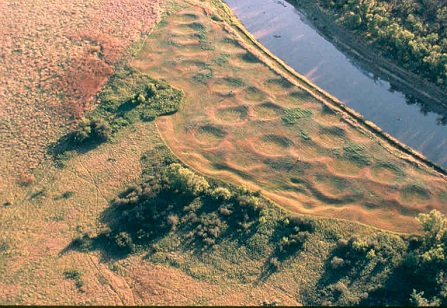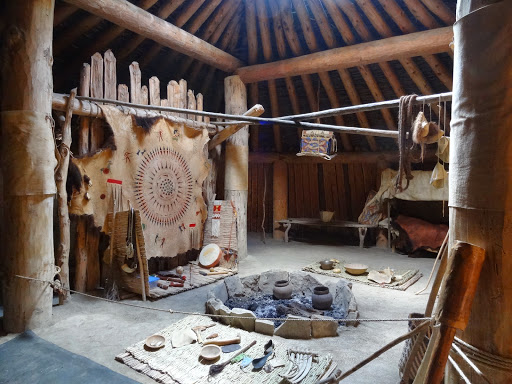July 10, 2021 The Ancient
Nearby Washburn, ND is the National Historic Site known as the Knife River Indian Villages. These villages were hubs of commerce; trading crops and wild game, horses, beads, other handiwork and especially prized Knife river flint with other tribes as far as the gulf coast and the pacific northwest. We visited early this morning before it got too hot to be out in the unrelenting sunshine. This aerial view shows the circular depressions marking the earth lodges of Awatixa Xi’e Village, also known as the Lower Hidatsa Village. It is believed to have been established around 1525 and continuously occupied until smallpox epidemics between 1780 to 1785 emptied the village. The Awatixa subgrooup of the Hidatsa returned to the area around 1790 to reestablish the village. Depressions in the earth of about 50 lodges, housing an estimated 500-600 inhabitants, are all that remain.
This aerial view shows the circular depressions marking the earth lodges of Awatixa Xi’e Village, also known as the Lower Hidatsa Village. It is believed to have been established around 1525 and continuously occupied until smallpox epidemics between 1780 to 1785 emptied the village. The Awatixa subgrooup of the Hidatsa returned to the area around 1790 to reestablish the village. Depressions in the earth of about 50 lodges, housing an estimated 500-600 inhabitants, are all that remain. A full scale reconstruction of an earthlodge is available to explore, as well as a native garden where corn, squash and beans (the three sisters combination) as well as melons and sunflowers are grown.
A full scale reconstruction of an earthlodge is available to explore, as well as a native garden where corn, squash and beans (the three sisters combination) as well as melons and sunflowers are grown. The interior of the lodge was roomy enough for 10-30 people of one or more families, dogs and a few prized horses, tied to a hitching post behind the decorative painted hide, to the side of the doorway vestibule.
The interior of the lodge was roomy enough for 10-30 people of one or more families, dogs and a few prized horses, tied to a hitching post behind the decorative painted hide, to the side of the doorway vestibule. A close up of the hide, a replica of the Mato-Tope, or Four Bears Exploit Robe. History of the robe can be seen here.
A close up of the hide, a replica of the Mato-Tope, or Four Bears Exploit Robe. History of the robe can be seen here.  On our walk around the quiet, green, peaceful grounds we found this owl feather (some believe owl feathers represent truth and knowledge). We left it for others to discover.
On our walk around the quiet, green, peaceful grounds we found this owl feather (some believe owl feathers represent truth and knowledge). We left it for others to discover.
